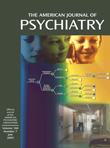This book on seasonal affective disorder arrived for review on one of those gun-metal gray, short November days that stretch into long gray November weeks, weather predictable for Michigan in late fall. On the cover is a lamplighter in the fog of a monochromic picture, so like the endlessly dark days of late fall and winter in the North. Those who might question the existence of this syndrome have only to spend some time in this continually cold and drab climate or, perhaps, more happily, can review the studies cited in this book and make a decision about the syndrome from a sunny location.
Seasonal affective disorder is a subtype of depression characterized by depressed mood, lack of energy, hypersomnia, craving for carbohydrates, overeating, and weight gain with a pattern of seasonal change
(1). A more prevalent but attenuated form of the disorder has been labeled “subsyndromal seasonal affective disorder.” Although the effect of the seasons on mood has been mentioned throughout the ages, light and its effect on seasonal variations in mood have been subjected to much more intense study since the early 1980s. An increased focus on exploration of circadian rhythms, along with the discovery of the effectiveness of bright light treatment and its subsequent commercial availability, has augmented the international study of this disorder. The syndrome is often explored in the popular press, leading to substantial public awareness. Perhaps some of the interest is due to the fact that there is anecdotal as well as research evidence that seasonal variations in mood may be present in the normal population.
The authors of this edited volume reside in Helsinki and Oslo, highlighting an issue addressed in the chapters on weather and on the latitude gradient in the prevalence of the rates of seasonal affective disorder. (Interestingly, when latitude-prevalence studies are summarized, there is a balance between studies confirming and studies rejecting the latitude-prevalence hypothesis [p. 134].) Partonen and Magnusson have condensed the expanding literature on this syndrome into a multichapter volume that provides a comprehensive review of seasonal affective disorder, with a particular focus on the winter subtype.
The volume is divided into two sections. The first highlights clinical issues, including symptoms and treatment, and is written for a wide range of health care and mental health professionals. The second section is more academic and research focused. All of the chapters in the book are heavily referenced and cite the latest international literature. The book is weighted toward review of the research in areas such as clinical symptoms (sleep, for example), neuroimaging, and biological clock genes. Throughout the book there is an objective view of the syndrome, including chapters about the controversial issues of the placebo effect of light therapy and the timing of successful light treatment. Explored from several different perspectives are the competing explanatory models for seasonal affective disorder—the phase shift hypothesis versus the melatonin hypothesis. Studies of response to light treatment have failed to resolve the conflict between these two hypotheses. The fact that morning light is more effective than evening light supports the phase shift hypothesis. On the other hand, the fact that evening light is more effective than control conditions supports the melatonin argument
(2,
3).
Like studies of the latitude-prevalence hypothesis, the examination of outcomes of studies has continued to raise more questions rather than providing a clear answer to many of the controversial issues regarding seasonal affective disorder. After reviewing this volume I had more of a sense of the uncertainty of the field than when I began. I can appreciate the excitement that research in this field generates because many questions remain to be answered. This book gives a good overview of the remaining controversial issues and is intellectually honest and unbiased in its approach. In summary, it is a fascinating review of research in this field that leaves the reader with an understanding of the issues and eager to see how they will ultimately be resolved.

